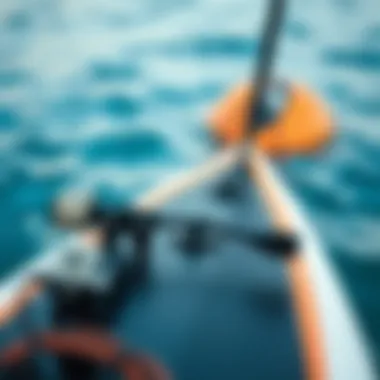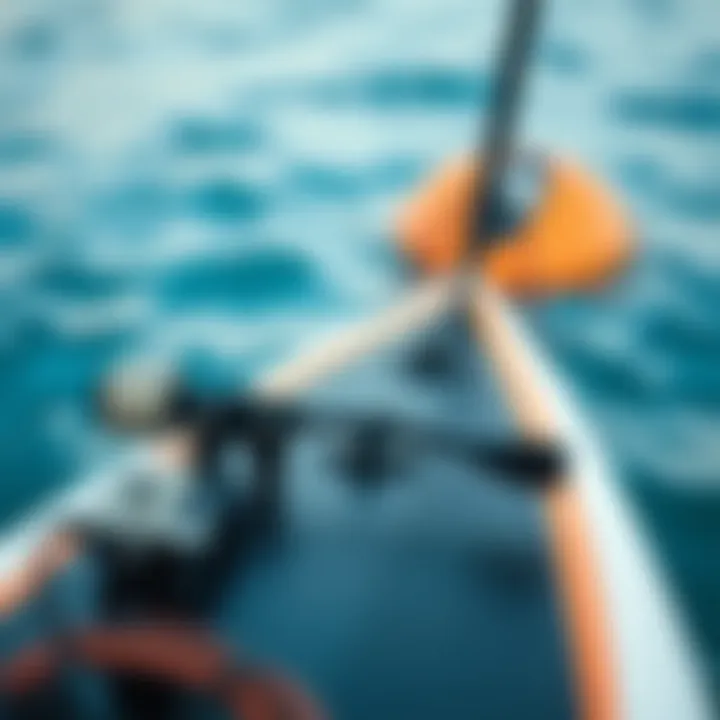Exploring Electric Hydrofoil Surfboards: A Comprehensive Guide


Intro
Electric hydrofoil surfboards have cast a spell over water sports enthusiasts, blending the excitement of surfing with cutting-edge technology. With their sleek design and ability to glide effortlessly above water, these boards are capturing the collective imagination of a new generation of riders. The electrification of hydrofoils has made it possible for both novices and experts to experience a newfound sense of freedom on water, riding without the constraints of wind or waves.
In this comprehensive guide, we will dissect every aspect of electric hydrofoil surfboards. From the intricate technology embedded within each board to the benefits they offer, we'll provide a thorough exploration of what makes these devices the future of watersports. We'll tackle vital concepts for potential buyers to consider to ensure they make the right choice, especially in a crowded marketplace filled with various brands and models. Furthermore, we’ll shed light on the parameters of maintenance, safety regulations, and the environmental implications of using electric hydrofoils. By the time you finish reading, you'll be well-equipped, not just to buy, but to fully appreciate the nuances of this fascinating technology.
"Riding an electric hydrofoil surfboard isn't just about the thrill; it’s about embracing a new way to connect with water."
So, whether you're a seasoned kiteboarder looking to expand your gear collection or a curious novice eager to dip your toes into an electrifying new realm, this guide is crafted for you. Armed with keen insights and valuable information, you’ll be ready to take your first ride on the waves.
Foreword to Electric Hydrofoil Surfboards
Electric hydrofoil surfboards have rapidly gained traction among water sports enthusiasts. They present an exciting blend of performance and innovation, setting a new standard in the surfing world. This section aims to underscore the significance of electric hydrofoils, outlining their unique features, potential benefits, and the considerations that riders should bear in mind before diving into this exhilarating water sport.
At their core, these boards allow riders to glide above the water, hovering on a hydrofoil that extends below the surface. This technology reduces drag significantly, enabling exhilarating speeds and a smooth ride. The thrill of slicing through the water—effortlessly powered by an electric motor—offers a unique experience, making it a fantastic alternative for those looking to break away from traditional surfing or kiteboarding.
One major draw of electric hydrofoil surfboards lies in their accessibility. Unlike traditional surfing, where waves greatly dictate conditions, hydrofoils can be used in a broader range of water situations, turning calm lakes or slow rivers into playgrounds for riders. This opens it up to a variety of skill levels, where beginners can enjoy the sensation of surfing without the daunting task of mastering the waves.
However, individuals interested in this technology should recognize certain factors that accompany its allure. The investment in a quality electric hydrofoil is no small commitment, with prices often reaching into the thousands. Also, riders must familiarize themselves with the new sensations and balance required when you're elevated above the surface.
"Electric hydrofoils are not just about speed; they redefine the relationship between rider and water."
This evolving landscape of hydrofoils also calls for an understanding of safety regulations and recommended gear. It’s imperative to know the local laws surrounding electric hydrofoils as they can vary drastically from one location to the next. Moreover, understanding the components and workings of an electric hydrofoil can empower riders in their decision-making process, ensuring they get the right board suited to their skill and interest level.
In summation, electric hydrofoil surfboards are not just a trend but represent a significant shift in the way we approach water sports. From accessibility factors to thrill-inducing technology, they warrant a thorough exploration. Through this guide, enthusiasts—be they kiteboarders, instructors, or marketers—will gain a comprehensive view to make informed choices in this ever-changing watersports arena.
Understanding Hydrofoil Technology
Understanding hydrofoil technology is vital for anyone interested in electric hydrofoil surfboards. This technology lies at the core of how these surfboards operate, allowing users to experience a unique blend of speed and agility on the water. Hydrofoils lift the board above the surface, reducing drag and enhancing glide, which can lead to a more enjoyable ride. Grasping the science behind hydrofoils helps in making informed decisions about design, performance, and suitability for individuals, especially for kiteboarders and instructors who might look to integrate this technology into their sessions.
Physics of Hydrofoils
At the center of hydrofoil technology is fluid dynamics, relating to how they interact with water. Hydrofoils generate lift as they move through the water, similar to how airplane wings function in the air. As the speed increases, the foil's shape allows for pressure differences, creating lift while allowing the board to rise above the water's surface. This lift reduces resistance and enables better maneuverability. The result is a smoother experience with higher speeds and less energy expenditure.
An interesting aspect is the angle of attack, which is the angle between the foil and the water's surface. A precise angle maximizes lift while minimizing drag. Understanding this concept is essential for users who want to optimize their riding experience.
Components of an Electric Hydrofoil
When it comes to electric hydrofoil surfboards, three essential components play a crucial role: the foil, the board, and the motor and battery. Each of these has its specific attributes that are pivotal for performance.
Foil
The foil itself is arguably one of the most significant components of an electric hydrofoil surfboard. Its design, often with a large surface area, allows for elevated lift which is essential to maintain stability and reduce the energy needed for riding. A key characteristic of foils is the material they are made from; optimally, they should be lightweight yet strong, favoring materials like carbon fiber or aluminum. This makes them a popular choice.
An advantage of modern foils is their ability to feature modular designs. This facilitates customization, allowing users to switch out wings based on their skill level or riding conditions. However, they can be sensitive to performance nuances, meaning a less experienced rider might struggle to find the right balance when adjusting the foil’s settings.
Board
The board is another critical component that directly influences rider experience. Boards come in various sizes and shapes, affecting how easy they are to control and how stable they feel on the water. A significant aspect to consider is the volume and shape of the board; this can significantly impact buoyancy and balance. Specifically, wider boards provide more stability, making them favored among beginners.
A unique feature that has gained traction is the ergonomic grip often found on boards, which aids in rider comfort and control. However, boards with higher volume may not be as nimble, which can be a downside for more experienced riders seeking agility in their maneuvers.
Motor and Battery
The motor and battery systems are the powerhouses behind electric hydrofoils. The motor must be potent enough to deliver a quick takeoff and maintain speeds, usually found in brushless designs. This type of motor is favored for its efficiency and durability.
When focusing on the battery, the capacity and charging time are vital. Lithium-based batteries are common due to their lightweight advantages and higher charge retention. However, a larger battery also adds weight, which can affect the hydrodynamics of the board. Ultimately, while more powerful motors can enhance performance, balancing performance with battery life and portability becomes an essential consideration in choosing an electric hydrofoil surfboard.
Overall, understanding each of these elements allows buyers to select equipment that fits their personal preferences and performance goals. The technology behind electric hydrofoils is evolving rapidly and knowing these components makes navigating the market much clearer.
Benefits of Electric Hydrofoil Surfboards


Electric hydrofoil surfboards have made quite a splash in the watersports world lately. With their ability to glide above the surface, these boards offer a range of benefits that appeal to both seasoned riders and curious beginners. By understanding these advantages, enthusiasts can appreciate what makes electric hydrofoils a compelling choice in water adventures.
Performance Enhancements
Performance is at the heart of any water sport, and electric hydrofoil surfboards bring it up a notch. Let's break down three key attributes: speed, stability, and efficiency.
Speed
Speed is really where electric hydrofoils shine. Unlike traditional surfboards that rely solely on waves and paddling, electric foils let riders hit impressive velocities with minimal effort. The key characteristic of speed through electric propulsion allows for rapid acceleration. Riders can seamlessly transition from cruising to zipping along the water. Moreover, the motorized aspect means chasing adrenaline becomes a lot easier, adding a thrill that riders often seek.
However, understanding the nuances of top speeds is crucial. For instance, some boards can reach over 30 km/h, while others may be more suited for leisurely rides at lower speeds. This variety empowers riders to select a model that meets their desires.
Stability
Stability is vital when one is soaring above water, especially for those still finding their footing on a hydrofoil. The design of these surfboards is such that they offer buoyancy and balance. A wide stance, along with well-placed foils, significantly contributes to stability during ride. This is particularly essential for beginners, who may have balance challenges when starting out.
For more advanced riders, a stable platform affords the chance to perform tricks or navigate choppier waters comfortably. It builds confidence, which is key to enhancing the overall riding experience.
Efficiency
Efficiency is another major advantage. Electric hydrofoil surfboards are designed to optimize energy use, allowing longer rides without depleting the battery too swiftly. The streamlined design ensures minimal drag, and when optimized, these boards maximize the distance covered per charge.
A notable feature is that some electric hydrofoils come equipped with regenerative braking, which can harness energy while riding. It’s like catching a wave backward—something traditional surfboards can’t do. This aspect not only entices those environmentally conscious riders but also ensures a satisfying ride time, making every session enjoyable without constant worry about battery life.
Accessibility for Beginners
Electric hydrofoil surfboards are not just for the pros. They are surprisingly accessible for those new to the sport. Many modern boards come equipped with user-friendly controls and features that make it easier for anyone to get started. With these boards, even those who may have never surfed are poise to take to the water comfortably. That factor is changing the dynamic of water sports, as more people can join in the fun.
One draw for beginners is the ease of learning. These boards often include stability features, so new riders can focus less on falling and more on enjoying the ride. Additionally, many brands offer tutorials and community support, so first-timers get the backing they need to build confidence.
In summary, electric hydrofoil surfboards bring forth a multitude of benefits. They enhance performance while also making riding accessible to beginners—the ideal combination for today’s water sports adventurers.
Current Market for Electric Hydrofoil Surfboards
The market for electric hydrofoil surfboards is evolving rapidly, with innovation driving a new wave of excitement among water sports enthusiasts. Understanding this market not only highlights the variety of available options but also provides insights into why these devices are generating so much buzz. The surge in interest suggests a shift in recreational habits, as more individuals seek unique experiences on the water.
With the technology advancing at breakneck speeds, many brands are stepping into this niche, bringing forth models that promise to enhance performance and accessibility. Investors and consumers alike have begun to recognize electric hydrofoils as more than just novelties; they're a sustainable means of enjoying aquatic environments, leading to increased demand and competition among manufacturers.
Popular Brands and Models
A handful of brands have emerged as leaders in the electric hydrofoil market, each offering distinct features aimed at meeting the needs of various riders. Some notable names include:
- Lift Foils: Regarded as one of the pioneers in the hydrofoil scene, this brand offers models known for their performance and innovative design. Lift Foils’ eFoil is particularly popular, appealing to those looking to glide silently above the water.
- Fliteboard: This company has made a name for itself by offering customizable options that cater to a wide range of surf styles. The Fliteboard is designed not only for efficiency but also to appeal to a diverse audience from beginners to seasoned riders.
- Arkatech: A newer player, Arkatech caters specifically to the eco-conscious. Their boards are constructed with sustainable materials, addressing growing concerns about environmental impact.
- Waydoo: With a focus on affordability without skimping on features, Waydoo’s electric hydrofoils present a compelling option for those seeking value—a balance of performance and cost.
These brands have models that cater to various experience levels, from beginner-friendly boards to high-performance options designed for advanced riders seeking thrills.
Price Ranges and Investment
When considering an electric hydrofoil surfboard, pricing plays a pivotal role in the decision-making process. Prices can vary significantly based on brand, features, and technology. Here's a breakdown of what consumers might expect:
- Entry-Level Boards: These models typically fall in the $3,500 to $5,000 range. They are suitable for beginners and offer decent performance without overwhelming the user.
- Mid-Range Boards: These boards usually cost between $5,000 and $8,000. They are often more equipped with advanced features, offering improved battery life and better handling.
- Premium Boards: Prices can soar above $8,000 for high-end models that are packed with cutting-edge technology, extended range, and luxurious designs. These are designed for those who expect the best performance and durability.
Purchasing an electric hydrofoil is not just about acquiring a new toy; it’s a significant investment. Therefore, it’s essential to weigh various factors including performance capabilities, battery longevity, and customer support when choosing a model. Additionally, the prospect of enjoying years of exciting rides can make such an investment worthwhile for enthusiasts.
"Investing in an electric hydrofoil is akin to stepping into a small revolution in water sports—one that continuously opens up fresh dimensions of adventure and enjoyment."
Understanding these price dynamics is crucial for anyone looking to dive into this thrilling experience. The electric hydrofoil market, albeit still growing, holds promise for many who appreciate water sports as well as those keen on embracing new technology.
Key Features to Evaluate When Buying
When considering the purchase of an electric hydrofoil surfboard, prospective buyers must weigh several key features to ensure a worthwhile investment. This decision involves not just aesthetics or brand reputation, but a thorough understanding of specific elements that directly impact performance, convenience, and overall enjoyment on the water. Knowledge of these features is crucial to making an informed choice, especially in a market that has recently burgeoned with various models and configurations.


Weight and Portability
The weight of an electric hydrofoil surfboard can significantly influence your experience. A lighter board facilitates easier handling, making it ideal for transporting to your local spot or even on travel adventures. For instance, a board weighing around 30 pounds could be manageable for most enthusiasts, whereas heavier options may require some muscle just to haul back to your car after a session.
Consider your typical use case. If you plan to travel or commute with your board, check the manufacturer's specs for not only the overall weight but also dimensions when folded or assembled. This matters because packing it into your vehicle or storing it at home needs to be hassle-free. Portability comes down to how easily you can move the board from A to B, and a board that’s cumbersome can mean missed opportunities on the water.
Battery Life and Charging Time
Another pivotal feature to evaluate is battery life. The range varies widely among different models, and this can make or break your day on the water. A board equipped with a robust battery can typically provide between 60 to 120 minutes of ride time, depending on factors like weight, speed, and water conditions. The last thing you want is to find yourself paddling back after just a few minutes because the battery died.
Moreover, understand the charging time required for your board. Models that boast fast charging capabilities are becomes advantageous if you plan to get several rides in a single day. A unit that charges within two to three hours can allow for multiple outings or back-to-back sessions if you're riding with friends. Therefore, weigh your choices based on how long you are willing to wait for a recharge and how that lines up with your riding aspirations.
Control Systems and Remote Functionality
Lastly, the control system and remote functionality warrant careful consideration. The way a board connects with its rider can significantly affect stability and responsiveness. Typically, modern boards come with wireless remotes that allow you to control speed and direction with ease. Key functionalities to look for include how intuitive the remote is and whether or not it has safety features like automatic cutoff, which can prevent accidents in case of a tumble.
Review user experiences with various remotes, as some may offer better ergonomics and responsiveness than others. The relationship between you and your board hinges on the control you have over it, which can elevate your performance or leave you struggling to keep balance.
"Testing the throttle and responsiveness during trial rides is essential to find the right balance and comfort with your new board."
Safety Considerations and Regulations
When it comes to electric hydrofoil surfboards, safety isn’t just a buzzword; it’s a crucial pillar that underpins the entire riding experience. As exhilarating as gliding over the water can be, understanding the inherent risks is vital. From beginners learning the ropes to seasoned riders pushing the limits, prioritizing safety ensures an enjoyable experience for everyone involved. Moreover, different regions might have unique safety laws, making it essential to stay informed.
Recommended Safety Gear
A wise rider knows that wearing the proper safety gear can make a world of difference. Here’s a breakdown of recommended equipment:
- Life Jackets: Always wear a personal flotation device (PFD) that fits snugly. Look for one designed specifically for water sports.
- Helmet: Protecting your head is a must. Opt for a water sports helmet that can withstand impacts without being cumbersome.
- Impact Vest: This provides extra flotation and protection for your torso in case of falls or collisions.
- Wetsuit or Drysuit: Depending on the water temperature, dressing correctly can protect you from hypothermia and abrasions.
- Footwear: Consider wearing water shoes with a good grip along the board to avoid slipping during maneuvers.
In addition to these, keeping a first-aid kit on hand, even for short rides, is a prudent choice.
Legal Regulations and Guidelines
Before hitting the water with your electric hydrofoil, familiarize yourself with local laws and regulations. Different areas can impose various rules regarding the use of electric watercraft, including:
- Speed Limits: Some locations may have specific speed constraints, especially in populated areas or near swimming zones.
- Restricted Zones: Be aware of areas where hydrofoil surfing may be banned or regulated to protect marine life or beachgoers.
- Licensing Requirements: Certain regions might require permits or licenses to operate electric surfboards. Check with local authorities or websites for precise guidelines.
- Insurance: Consider insurance policies that cover accidents or damage caused by watercraft to safeguard yourself financially.
Always remember, navigating the legal landscape with care not only promotes your safety but also the safety and enjoyment of those around you.
Staying informed about — and adhering to — safety gear recommendations and legal regulations can elevate your riding experience. It not only ensures your safety but contributes to a culture of responsibility within the electric hydrofoil community. Keep it safe, keep it fun!
Maintenance and Care for Hydrofoil Surfboards
Keeping electric hydrofoil surfboards in prime shape isn’t just a question of aesthetics; it significantly impacts performance and longevity. Just like any high-end gadget, if you want it to last, a little TLC (tender loving care) goes a long way. Maintenance can also ensure optimal performance, allowing riders to have a better experience on the water. When owners invest in quality equipment, they should be equally invested in its upkeep.
Routine Maintenance Tips
Cleaning
Cleaning is the heartbeat of maintenance. It involves regular checks and scrubs that prevent major issues down the line. Saltwater, sand, and grime can wreak havoc if left unchecked. After every session, it's a good idea to rinse off your board with fresh water to wash away any salt residue. Salt can corrode components and lead to premature wear.
- Key Characteristic: Keeping your surfboard clean enhances performance. A slick, clean surface means less drag when slicing through water.
- Unique Feature: Using specialized cleaning agents can help maintain the integrity of the materials. Regular household soaps can sometimes be too harsh, leading to micro-damage.
- Advantages: A well-cleaned surfboard not only looks good but also performs better. This contributes to a smoother ride for beginners and experts alike.
Storage
When it comes to storage, the right techniques can be a game-changer in preserving the performance of your hydrofoil. Storing it properly minimizes damages from UV light and fluctuating temperatures, which can warp the board or degrade the battery lifespan.
- Key Characteristic: A good storage strategy keeps your board safe from accidental knocks and environmental factors. If you’re keeping it outside, a protective cover can be a lifesaver.
- Unique Feature: Vertical storage options are becoming popular as they take less space and can offer more air circulation, which helps in keeping components dry.
- Advantages: Long-term storage done right ensures that your board is ready to hit the waves without requiring immediate extensive maintenance just before your next adventure.
Troubleshooting Common Issues


Even with the best care, issues can arise. Familiarizing yourself with common troubleshooting techniques can save you from unnecessary headaches.
1. Battery Problems: If the battery isn’t holding a charge, check for corrosion on terminals or wear in connectors. These components are crucial to getting the most out of your ride.
2. Foil Damage: Any nicks or bends on the foil can seriously affect performance. A visual inspection is crucial; fix small dings immediately before they get worse.
3. Control System Glitches: If you've lost connection to your remote control, first ensure that both the remote and the board are adequately charged. Sometimes, it's just a simple reset.
By actively engaging in regular maintenance and staying ahead of potential issues, you'll ensure an extended life for your electric hydrofoil surfboard, making each outing both enjoyable and hassle-free.
Environmental Impact of Electric Hydrofoils
Understanding the environmental implications of electric hydrofoil surfboards is crucial to promoting responsible water sports. As enthusiasts ride the waves powered by these innovative devices, it's essential to reflect on their impact on our oceans and ecosystems. The focus on sustainability is more than a mere trend; it reflects a growing awareness that the activities we love must coexist with the planet’s health.
Sustainability and Eco-Friendly Options
Electric hydrofoils present a unique opportunity to engage with the water while minimizing one’s carbon footprint. Many manufacturers are now exploring sustainable practices in materials and production processes. For instance, some surfboards are made from recycled or biodegradable materials, which significantly reduces their ecological footprint.
- Battery Choices: Emerging technologies focus on lithium-ion batteries that, while still needing careful disposal, hold a kWh of energy efficiently. Furthermore, companies are looking into bio-based batteries that use natural elements rather than traditional chemicals.
- Energy Efficiency: The design of electric hydrofoils aims to reduce energy consumption while maximizing output. Riders can experience greater speeds while using less battery, which translates into fewer carbon emissions per ride.
- Renewable Energy Integration: Some brands are taking it a step further by encouraging the use of solar chargers for battery management. Picture enjoying a sunset ride while your board regenerates energy from the sun; it’s a fantastic blend of technology and nature.
In summary, the aim is to create products not only for performance but also for responsible enjoyment of our natural surroundings.
Impact on Marine Life
When engaging in any water sports, it's important to consider the interactions with marine ecosystems. Electric hydrofoils, despite their advantages, are not without their challenges regarding marine life.
The noise levels of electric motors can affect marine species, particularly those that rely on echolocation or have sensitive hearing. Although these sounds are generally lower than those from gas-powered boats, they’re still present. Additionally, some species might avoid areas frequently traversed by hydrofoils, resulting in habitat disruption.
"Understanding our impact on the ocean begins with recognizing the creatures that inhabit it and the delicate balance we might inadvertently disrupt."
Moreover, the physical presence of these surfboards in marine environments raises questions about potential disturbances. If hydrofoils are used in crowded areas, they might unintentionally collide with wildlife or damage sensitive plant life, such as seagrasses. Riders must educate themselves and remain cautious while operating these boards around natural habitats, especially during breeding seasons for various species.
Future Trends in Hydrofoil Technology
The electric hydrofoil surfboard market is evolving rapidly, with innovations shaping the future of this exhilarating water sport. Understanding the forthcoming trends is essential for enthusiasts, potential buyers, and marketers, as it sets the stage for what to expect in terms of performance, accessibility, and environmental impact. This section will delve into two key areas: advancements in battery technology and the integration of hydrofoils with other water sports. These advancements not only promise to enhance user experience but also emphasize sustainability and broader accessibility.
Advancements in Battery Technology
Battery technology is a cornerstone of the electric hydrofoil surfboard experience. Recent years have seen a significant push toward more powerful, efficient, and lightweight battery systems. For instance, lithium-ion batteries have remained popular, but new formulations are on the horizon. With these advancements, we can anticipate batteries that last longer, charge faster, and weigh less, making boards easier to transport and handle.
Consider the recent development of solid-state batteries, which may become predominant in this market. Compared to traditional lithium-ion batteries, solid-state batteries promise higher energy densities, which could lead to longer rides without the need to charge frequently.
Key benefits of these advancements include:
- Extended Range: Riders could potentially enjoy longer sessions on the water without interruptions.
- Enhanced Safety: Solid-state batteries reduce the risk of fire, making them a safer choice for consumers.
- Faster Charging Times: Improved technology might cut charging times down significantly, meaning riders don’t have to wait long before getting back on the water.
"As battery technology continues to progress, riders will enjoy a more seamless experience, blending adventure with fewer constraints of time and distance."
Integration with Other Water Sports
The versatility of electric hydrofoil surfboards is becoming more apparent as manufacturers look to integrate their products with other water sports. For example, brands are now developing hybrid boards that allow for a smooth transition from surfing to paddleboarding or even kiteboarding. This adaptability widens the audience base and provides riders with the option to switch styles without needing separate boards.
This trend offers considerable advantages:
- Broadened Audience: Surfers, kiteboarders, and paddleboarders can all find utility in a single board.
- Shared Technology: Sharing advancements in components—like better control systems—across different types of boards can help improve overall product quality and performance.
- Environmental Considerations: Riding on a multi-sport board could lower the demand for multiple boards, ultimately reducing material and manufacturing impacts on the environment.
As these integrations become more commonplace, expect to see collaboration among brands and the emergence of comprehensive platforms that provide a seamless experience across various water sports.
Finale: The Evolving Landscape of Electric Hydrofoils
In recent years, the electric hydrofoil surfboard has transformed water sports, merging technology with the thrill of riding the waves. This evolution is not just about the device itself but also about how it impacts users and the broader water sports community. As the popularity of electric hydrofoils grows, understanding their implications becomes crucial for kiteboarders, instructors, marketers, and travel agents alike.
One important aspect of this transformation is the accessibility these boards offer. With advancements in designs and improvements in safety features, newcomers to the sport can experience the joy of foiling without the steep learning curve typically associated with traditional surfboards or kiteboards. This opens new doors for instructors looking to diversify their offerings and attract a wider range of students. The thrill of gliding above the water surface is now within reach for many who previously found hydrofoil surfing intimidating.
Moreover, as manufacturers introduce cutting-edge technology, buyers are increasingly faced with choices that factor in performance, portability, and overall experience. With a variety of models catering to different skill levels, consumers can now find electric hydrofoil surfboards tailored to their specific needs. This is essential for travel agents who want to ensure their clients have an enjoyable and hassle-free experience on the water.
"The advancements in electric hydrofoil technology exemplify the synergy between innovation and recreation, paving the way for a promising future in water sports."
The evolving landscape is not just about individual experiences; it also prompts environmental considerations. As these surfboards gain traction, it is imperative to advocate for sustainable practices. Many companies now emphasize eco-friendly materials and battery technologies that lessen the environmental footprint. This aspect must be highlighted by marketers aiming to connect with an increasingly eco-conscious clientele.







